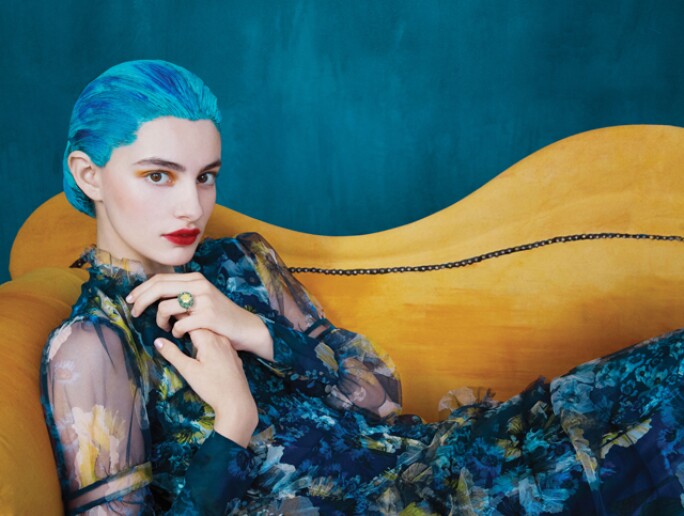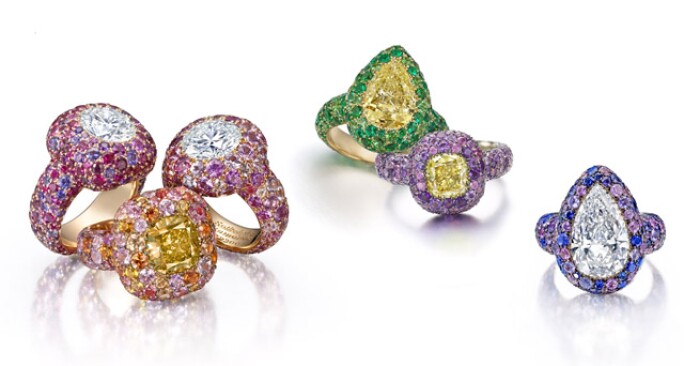T he new Sotheby's Diamonds campaign was photographed by renowned photographer, Erik Madigan Heck, whose innovative approach to photography incorporates visual elements from the key moments in art history. Drawing on influences from the arresting portraits of Dutch Old Master paintings to the textures and colour palette of the Impressionist and Modern masters, Heck is able to marry his fascination with both classical and contemporary painting with high fashion, to produce timeless images that cross visual boundaries. Heck explains: "it is very important that the work be referential to different periods in art history that tie in quite overtly".

It is this extraordinary vision that so perfectly fits with the ethos of Sotheby's Diamonds. Drawing on our illustrious history in the worlds of both fine art and fine jewellery, the campaigns — as well as the jewels themselves — focus on texture, light and form to create exceptionally designed pieces, unique to Sotheby's. To further explore the origins of this creative process, James Mackie, Head of Sotheby's Impressionist & Modern Art Department in London, traces the influence of the Impressionists in Heck's photographs.
Edgar Degas
"For me this photograph says Degas! There are strong echoes of the ballet dancers, bathers and the sitters in repose that populate Degas' unique oeuvre. In particular this image triggers an association with the Musee D'Orsay’s Two Dancers in Blue. The work is a tour de force of Degas' mastery of pastel in which he fuses colour and line in a complex layering of the medium. In Two Dancers in blue we see the two figures reclining in the wings of a theatre, a setting that finds an echo in this photograph. As so often in Degas' work we are made witness to a private moment and the seemingly unguarded moment of contemplation captured in the photograph relates directly to this theme in Degas' work."

"His enduring fascination for the depiction of the human form, in particular the female form, was the preeminent driver of Degas' art and is characterised by the somewhat contorted postures of the two dancers in the Musee D'Orsay work. The challenge of capturing in pastels both the complexity of this model's pose and the rich colour of the draperies would doubtless have been relished by Degas were he here today."
Henri Matisse
"The reclining pose of the model in this image is immediately striking and brings to mind Henri Matisse's Odalisque paintings. Throughout his life Matisse approached clothes and textiles with the eye of a collector. What developed out of this interest was the great series of Odalisques that explore the relationship between his model, her clothes and often sumptuous surroundings, all of which were meticulously arranged by the artist."
"As the sequence of paintings unfold the inherent themes and variations create a mystery that deepens the more we look, something that resonates in the photograph. In Odalisque au fauteuil noir the sitter is Princess Nezy, granddaughter of the last Sultan of Turkey. She sits against a rich orientalist background, swathed in delicate fabrics and wearing jewellery at her neck and wrists. The affect is one of lusciousness and beauty akin to that of the photograph of the model on a yellow sofa."

Édouard Manet
"This image of the Getty Museum's Le Printemps by Manet is so evocative. A hit with the critics and public alike when it was exhibited at the Paris Salon of 1882 the painting is one of Manet's last great masterpieces. It is a work of great beauty and epitomizes Manet's concept of modernity and femininity. The lavish treatment of the dress is echoed in the photograph here."
"The parasol forms an important part of the composition, reflecting the contemporary interest in japonisme. Though Manet never considered himself a member of the Impressionist group, he worked alongside them and exerted huge influence over their work; the parasol would go on to be a recurring motif in the work of the Impressionist artists."

"One thinks immediately of Monet's The Stroll, but it is in Renoir's work that we see the recurring motif of the parasol most often.
The Ricci Collection captures the intense colours and shimmering light of the Grand Bleu – the spirit and glamour of the Riviera and the sensuality of the South of France. Each of these exuberant cocktail rings is centred on a spectacular diamond, meticulously cut to unleash its brilliance, and framed in a voluptuous border set with a symphony of coloured stones.
Read Erik Madigan Heck's interview on his collaboration with Sotheby's Diamonds here.







